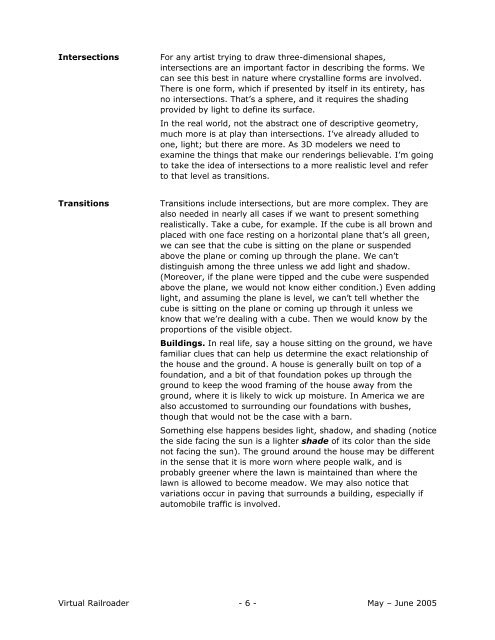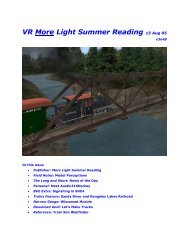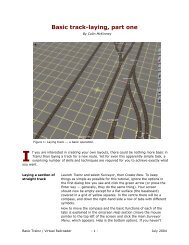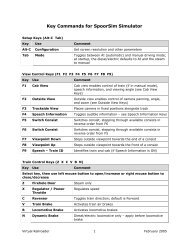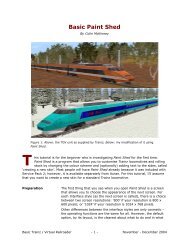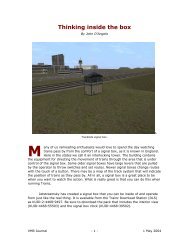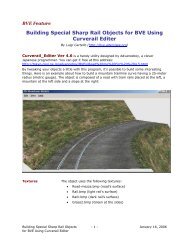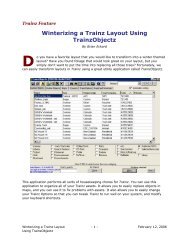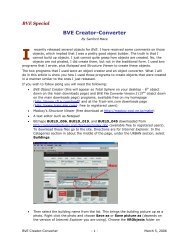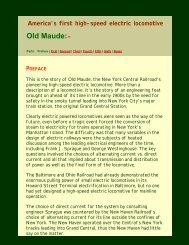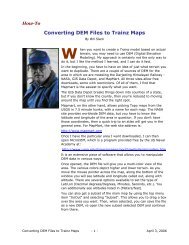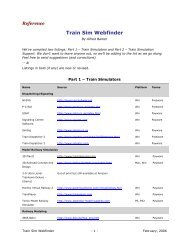View/save (right click) file - Virtual Railroader
View/save (right click) file - Virtual Railroader
View/save (right click) file - Virtual Railroader
You also want an ePaper? Increase the reach of your titles
YUMPU automatically turns print PDFs into web optimized ePapers that Google loves.
Intersections<br />
For any artist trying to draw three-dimensional shapes,<br />
intersections are an important factor in describing the forms. We<br />
can see this best in nature where crystalline forms are involved.<br />
There is one form, which if presented by itself in its entirety, has<br />
no intersections. That’s a sphere, and it requires the shading<br />
provided by light to define its surface.<br />
In the real world, not the abstract one of descriptive geometry,<br />
much more is at play than intersections. I’ve already alluded to<br />
one, light; but there are more. As 3D modelers we need to<br />
examine the things that make our renderings believable. I’m going<br />
to take the idea of intersections to a more realistic level and refer<br />
to that level as transitions.<br />
Transitions<br />
Transitions include intersections, but are more complex. They are<br />
also needed in nearly all cases if we want to present something<br />
realistically. Take a cube, for example. If the cube is all brown and<br />
placed with one face resting on a horizontal plane that’s all green,<br />
we can see that the cube is sitting on the plane or suspended<br />
above the plane or coming up through the plane. We can’t<br />
distinguish among the three unless we add light and shadow.<br />
(Moreover, if the plane were tipped and the cube were suspended<br />
above the plane, we would not know either condition.) Even adding<br />
light, and assuming the plane is level, we can’t tell whether the<br />
cube is sitting on the plane or coming up through it unless we<br />
know that we’re dealing with a cube. Then we would know by the<br />
proportions of the visible object.<br />
Buildings. In real life, say a house sitting on the ground, we have<br />
familiar clues that can help us determine the exact relationship of<br />
the house and the ground. A house is generally built on top of a<br />
foundation, and a bit of that foundation pokes up through the<br />
ground to keep the wood framing of the house away from the<br />
ground, where it is likely to wick up moisture. In America we are<br />
also accustomed to surrounding our foundations with bushes,<br />
though that would not be the case with a barn.<br />
Something else happens besides light, shadow, and shading (notice<br />
the side facing the sun is a lighter shade of its color than the side<br />
not facing the sun). The ground around the house may be different<br />
in the sense that it is more worn where people walk, and is<br />
probably greener where the lawn is maintained than where the<br />
lawn is allowed to become meadow. We may also notice that<br />
variations occur in paving that surrounds a building, especially if<br />
automobile traffic is involved.<br />
<strong>Virtual</strong> <strong>Railroader</strong> - 6 - May – June 2005


